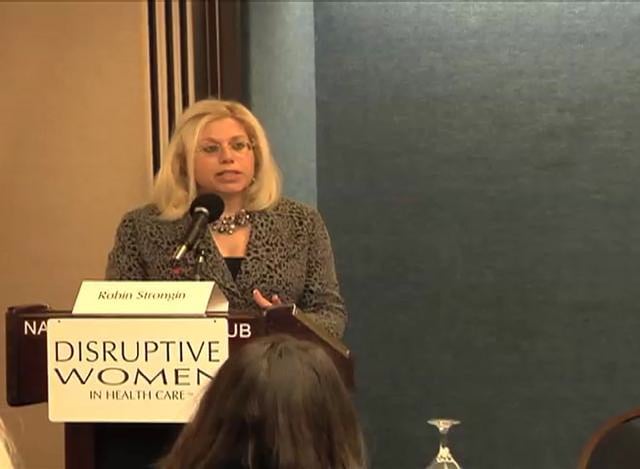I attended a great Disruptive Women in Health Care event last week: Health Reform After the 2010 Election – Assessing the Viability of Health Insurance in the Aftermath of the Mid-Term Elections.
A big title, but it’s a big topic.
In a series of panel discussions, a varied group of healthcare policy wonks and a smattering of journalists offered their perspectives on what the future of healthcare payment & health insurance reform is, given that control of the House is now in Republican hands, and the Senate super-majority won by the Democrats in 2008 is history.
With the economy in the tank since before the 2008 election, and little to show for the massive injection of federal money to bail out the financial markets and the auto industry (other than a continuing 9+% national unemployment rate), it still seems quixotic that the Obama administration picked healthcare reform as its first big policy project.
Dan Gerstein, a Forbes columnist and former legislative aide to Senator Joe Lieberman, said during the first panel discussion, “this was a perfect storm of bad execution on the part of the Democrats.” With the economy and jobs a much larger, and more personal, issue to most of the electorate, the 9 months it took to push the healthcare reform act through Congress took a big toll on the public’s perception of the Obama administration.
Which, in turn, took a big toll on the Democratic Party’s results on Nov. 2.
Now, whither healthcare reform? It seems that the watchword will be replace, not repeal.
Nancy Johnson, who served 24 years representing Connecticut in the US House and is now a public policy advisor at Baker Donelson, said, “people are beyond parties now. Two things have gone fundamentally wrong: endless use of credit, which has led to fiscal collapse.” That translates to an unwillingness, particularly on the part of the states, to fund healthcare reform as it currently stands.
Now that the President will have to deal with a much less amenable Congress, Jim Slattery, a six-term Congressman from Kansas and now a partner at law firm Wiley Rein, said, “the President has a tough choice to make, and only a few weeks to make it. Confrontation or cooperation?” He noted that in a democracy, “compromise is a great substitute for violence,” but I wonder how much of a figurative beating the desire for systemic healthcare reform will take in the name of compromise.
Stay tuned on that one.
The second panel discussion spoke directly about the issue of health insurance: access/availability and affordability. One of the central issues facing the health insurance market is this: if the government is mandating insurance coverage, redefining the role of insurance agents and brokers will be an interesting battleground.
David Reynolds, President & CEO of Coventry Health Care in Maryland and Delaware, thinks that those agents and brokers would be ideal navigators of the new system. But how will they be remunerated for serving as navigators, particularly on the lower end of the market?
Slattery said that moving healthcare toward a utility model, where public utilities are private companies operating under public regulation on price and access, might be the right answer. Add to that the idea of moving the healthcare delivery system from an illness-treatment to an illness-prevention model and we might see some actual bending of the cost curve.
The session wound up with a discussion of what the insurance market might look like with the new Congressional landscape. Janet Trautwein, CEO of the National Association of Health Underwriters (NAHU), which represents more than 100,000 employee benefits and health plan management professionals across the US, echoed Reynold’s statement that agents and brokers were valuable advisors to companies working to understand the impact of the healthcare reform act. She also noted that the staggering $1Trillion-with-a-T price tag of reform was just the government share of the financial impact of healthcare reform.
Leslie V. Norwalk, who served as Acting Administrator for the Centers for Medicare & Medicaid Services (CMS) in the George W. Bush adminstration, observed that companies might elect to pay the $2,000-per-employee fine for not offering healthcare coverage to their workers, since coverage typically costs between $3,000-$8,000 per employee per year. Even if they pay the fine, and offer their workers $1,000 each toward buying their own insurance, they’d at least break even – and they might save a significant amount of money.
Think of it from the perspective of a Fortune 50 who employs more than 100,000 people – get my drift?
Did the folks drafting the legislation even think of that possibility when structuring it? Were their calculators broken?
My take-away from the morning’s discussion – which I have to say I was delighted to have been in the room for – was that both sides of the aisle believe that the healthcare payment system in the US has fallen, and it can’t get up. The issue at hand now, with the new Congressional balance of power, is how to tweak/replace/re-tool needed reform without increasing the federal debt, and while simultaneously creating a system that truly offers access to all.
I’m a believer in the consumer-driven model, with HSAs for everybody. Encourage people to be active consumers, not passive meat puppets, when it comes to their health and healthcare. Will Congress agree? Stay tuned.
That’s my story, and I’m stickin’ to it….
Here’s some video of the morning’s events:
Disruptive Women Panel #1 – November 3, 2010 from Amplify Public Affairs on Vimeo.




